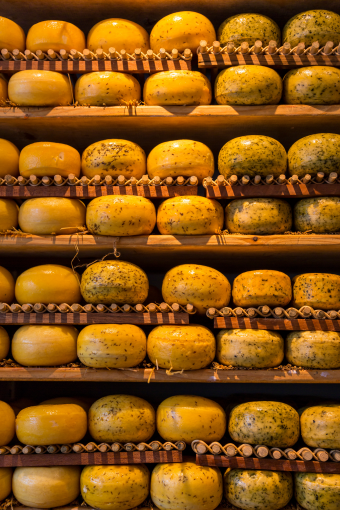Why Some Cheeses Come in Wheels and Others in Blocks
 Whether a block, a wheel, a cylinder or a pyramid, a cheese’s shape is dictated by concerns with pressure, salt absorption, ripening, economics and/or tradition.
Whether a block, a wheel, a cylinder or a pyramid, a cheese’s shape is dictated by concerns with pressure, salt absorption, ripening, economics and/or tradition.
Cheeses that are made in wheels, like creamy Brie and Camembert, need equal rates of salt uptake, as well as even ripening action from its molds (like P. camemberti and P. candidum) as they break down the milk proteins and produce the delicious ambrosia within. The wheel shape facilitates both as the consistent thickness encourages equal absorption as the surface flora spread; so the disk’s shape keeps the mold from focusing too much on one area (as it would if there were, for instance, square corners, where a higher percentage of molds would work on the edge areas, resulting in an over-ripened edge. These edges in square blocks are often a source of problems in many cheeses if the cheese maker doesn’t get the conditions just right).
Another reason to make a cheese in a wheel, at least historically, is pressure. For example, for traditional rind-covered cheddars, the dry salting method used in their production needs quite a bit of pressure to hold the curd together until it is able to stick on its own. The round molds provide extra strength in pressing, where rectangular molds of the same thickness, even stainless steel ones, tend to lose their shape and even split at the seams over time. As one professional cheese maker noted on the durability of these molds, “design engineers who know cheese plants typically design the item, then double it.”
A third reason for making cheese into a wheel, particularly for those produced in mammoth proportions, is that you can just roll the large wheel rather than lugging it about. Historically, cheese wheels were often made in these very large sizes for sale to marketplaces and if you wanted to buy cheese from the market, you used to have to ask the seller to cut off the amount you wanted from these very large wheels, rather than have cheese you could buy pre-packaged in consumer sized portions.
If none of these issues are a concern, then making cheese in a block (often from large blocks that are then cut into smaller blocks for consumer usage) is often a wise choice as blocks are easier and more economical to stack, store and transport over long distances.
Other shapes are used as well, sometimes as much to do with tradition as anything else thanks to modern cheese making equipment and environmental controls. These include cylinders and pyramids, which are very popular with goat’s milk cheeses like chèvre. In fact, in France the shape of a goat’s milk cheese tells savvy consumers instantly where their cheese originated. For example, the flat disk of Banon is known to originate in Provençe, while a log of the mild and creamy Montrachet comes from Burgundy, and the striking cheese of Valençay, called either Valançay or Pyramide, is instantly recognizable for its flat-topped pyramidal shape (and loved for its mild nutty flavor).
If you liked this article, you might also enjoy our new popular podcast, The BrainFood Show (iTunes, Spotify, Google Play Music, Feed), as well as:
- Is it Safe to Eat Moldy Bread or Moldy Cheese?
- The Origin of “Say Cheese” and When People Started Smiling in Photographs
- The Corrupt and Ruthless Californian Who Gave us the Name for “Monterey Jack” Cheese
- Mice Don’t Like Cheese
- The Origin of the Expression “The Big Cheese”
Bonus Facts:
- There are several molds that are used in cheese-making depending on the desired product. In addition to P. camemberti and P. candidum listed above, a number of other species of penicillium are used as well. For example, to make blue cheeses, including Blue, Stilton, Gorgonzola and Roquefort, either P. roqueforti or P. glaucum are employed. Able to thrive with little oxygen, these molds work their way through the small cracks inside a ripening cheese. Notably, to encourage even more blue-veined goodness, some cheese makers actually inoculate (read: inject) their cheeses with additional mold.
- Not restricted to molds, bacteria play a large role in cheese production as well. Vital to the initial formation of a cheese, lactic acid bacteria such as lactococci and lactobacilli eat the milk’s sugar, lactose, and help convert it into lactic acid. Although these early bacteria often die off early in the process, for some cheeses like Gruyere, Pecorino Romano and Grana Padana, some of these bacteria survive to help produce these cheeses’ unique properties. In addition, other bacteria may play a role later in the cheese’s metamorphosis. For example, Propionobacter shermanii eat acetic acid and produce carbon dioxide, and are used in making Swiss and Emmental cheeses where they are key to producing their unique flavors and trademark holes.
- Another bacteria, Brevibacter linens, is used to make some truly smelly, but delicious, cheeses like Epoisses and Limburger. Breaking down proteins into pungent-smelly-tempting aromas (like onion and garlic), B. linens requires continuous washing and wiping of the surface (or smearing, hence the category “smear bacteria”), to keep the bacteria alive. If the smearing is continued during the entire maturation process, a truly stinking cheese is produced, but it if the washing is stopped mid-way, milder cheese may result.
- A guilty (and often secret) pleasure, although there is no consensus on the world’s smelliest cheese, those that consistently rank in the top five are Limburger, Époisses de Bourgogne and Stinking Bishop.
- In 2004 researchers at Cranfield University used a machine fitted with sensors that were able to detect the different smelly chemicals of stink, as well as the contributions of 19 humans who sacrificed their noses, to determine that Vieux Boulogne was the absolute stinkiest cheese.
| Share the Knowledge! |
|





2 comments